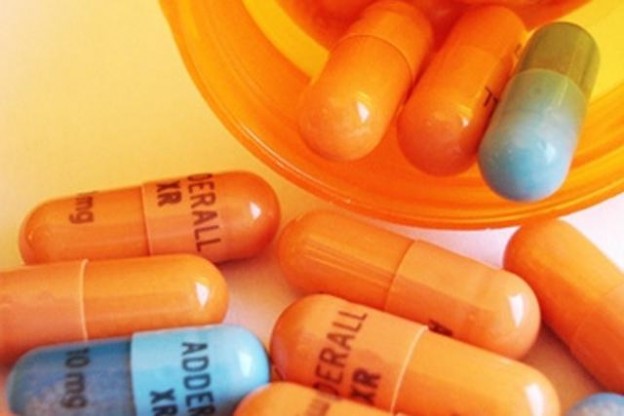By Kevin Cann – Steroidal.com
Rates of Attention Deficit Disorder (ADD) and Attention Deficit Hyperactivity Disorder (ADHD) are on the rise. More and more school aged children are getting diagnosed with these disorders and then prescribed medication that accompanies this diagnosis. Many of these children getting diagnosed with ADD or ADHD play sports, are they getting a competitive advantage over their peers?
Adderall is a member of the amphetamine class of drugs. It works by increasing the amounts of norepinephrine and dopamine in our system. Norepinephrine and dopamine are both neurotransmitters that help improve memory, focus, and energy. Makes sense why this drug is utilized with conditions such as ADD, ADHD, and even narcolepsy. Some of the side effects of Adderall include increased heart rate and anxiety.
 I decided to look at Adderall and its performance enhancing effects after hearing about one of the New England Patriots defensive backs was suspended 4 games for the drug. Other big name NFL players that have been suspended for Adderall are Seahawks defensive back Richard Sherman, and the Ravens defensive tackle Haloti Ngata.
I decided to look at Adderall and its performance enhancing effects after hearing about one of the New England Patriots defensive backs was suspended 4 games for the drug. Other big name NFL players that have been suspended for Adderall are Seahawks defensive back Richard Sherman, and the Ravens defensive tackle Haloti Ngata.
According to Dr. Gary Waldman, a former chairman of the anti-doping agency, “There’s no question it (Adderall) is a performance enhancing drug.” This makes sense as the medication helps improve our memory, focus, and energy. However, if this prescription medication is so bad why do we prescribe it to children?
Research has shown that exercise naturally raises dopamine levels (1). This tells us that dopamine plays a role in our abilities to move around. This makes sense as physical activity for the greater part of our genome meant escaping danger. In life and death situations we would need to have enough energy to fight or runaway and have enough focus to react, and hopefully remember so we do not make the same mistake again. But what happens when we overtrain?
Think of the times when you may have been overtraining. Some of the signs and symptoms are fatigue, poor mood, increased soreness, and a drop in performance. From a chemical standpoint overtraining leads to a change in our neurotransmitters. Evidence suggests that the catecholamines such as dopamine and norepinephrine play a critical role in developing fatigue (2).
There is no doubt that NFL players, or any professional athletes for that matter, participate in high level physical activity that can lead to overtraining. Their jobs are to work out and perform at high levels. I would bet bottom dollar that if someone came in and tested the NFL for levels of neurotransmitters they would be dysfunctional across the board. If doctors prescribe Adderall to children with these dysfunctions why would it be a big deal for adults to take these medications?
The answer that the anti-doping agency will give is that there will be an unfair gain in performance. Sadly the anti-doping agency lives on another planet and fails to recognize that the majority of professional athletes are on some form of performance enhancing drug. Their testing abilities are just so far behind modern science that only the stupid athletes get caught. Also, the NFL is going through a lawsuit due to the rising number of head injuries and mental illness that plagues many players long after their careers are finished.
According to an article published on Forbes.com, NFL players have a 30% chance of Alzheimer’s or Parkinson’s disease. This is a much higher number then the general population. The NFL and its researchers would like us to believe that these numbers are this high because of too many hits to the head. Therefore, their preventative measures are to make those hits illegal, and force people to tackle lower on the body. This will undoubtedly lead to a spike in lower extremity injuries, but that is a bone to pick at another time.
Research has shown that low dopamine levels are associated with increased risk of Parkinson’s, Alzheimer’s, and other neurodegenerative diseases (3). Low levels of norepinephrine and dopamine have also been shown to lead to increases in mood disorders. Perhaps the NFL and its researchers should look at studies such as this one to develop preventative measures to protect its players.
Adderall may be beneficial to make sure that the catecholamine levels of NFL players stay balanced and do not drop too low. It is prescribed to children so it can’t be banned because it is dangerous. There are more natural ways to raise the levels of our catecholamines. We can use specific amino acids such as phenylalanine and tyrosine to raise norepinephrine and dopamine. This could be a way to help decrease risk of neurodegeneration and mood disorders in high level athletes.
References:
[1]. Mov Disord. Dec 15, 2010; 25(16): 2777–2784.
[2]. Appl Physiol Nutr Metab. 2007 Oct;32(5):857-64.
[3]. Ann Neurol. 1993 Sep;34(3):324-30.







